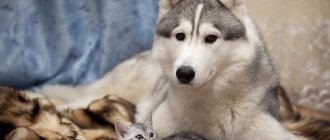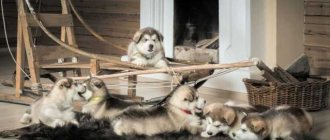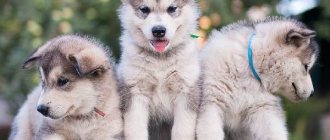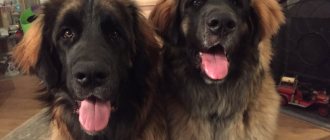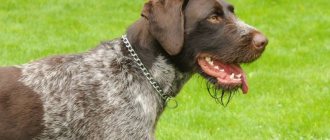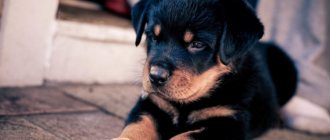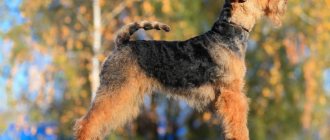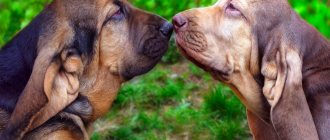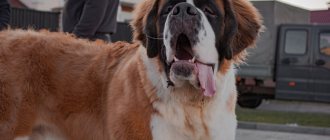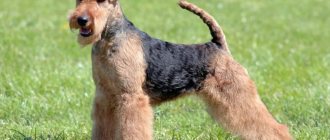The variety of dog breeds never ceases to amaze the human mind. Each of them, be it small breed mixed breed puppies or a mulatto dog, is sweet and beautiful in its own way. Moreover, all four-legged friends of man are loyal to their owner, regardless of size, eye color or ancestors. A particularly interesting topic in this case is the description of mixed-breed dogs, which are the result of inbreeding of several breeds.
These puppies are born when different breeds of dogs are deliberately crossed.
Features of mixed-breed dogs
As a rule, a mixed breed dog means that the representative's parents were purebred, but of different species, as in the photo. The idea that mixed breeds are better than purebreds is not without merit. Experts believe that a puppy takes only the best qualities from its different parents, which is why representatives of mixed breeds are more friendly, intelligent and have good health.
A mixture of representatives usually balances out the negative traits of the breed. However, mestizos are often difficult to educate and train, especially stubborn and unwilling to obey. Training should be carried out jointly with an experienced specialist; it is extremely important to avoid aggression, but to be demanding, consistent and unwavering in your goal.
Some representatives of mestizos have a tendency towards aggression, especially towards other pets. If you are not buying a small puppy, but one that has already been with its owners, it is better to take a closer look at it; over time, aggression towards people may appear.
What it is?
Mixed breeds are puppies obtained from parents of different breeds. They appear for several reasons.
- When the owner did not keep an eye on the dog, and an accidental mating occurred. Animals can take on the character and appearance of both parents. The result is unpredictable and such puppies are not worth paying money for, they are given “in good hands.”
- The conscious work of breeders to cross different breeds of dogs in order to improve their appearance, working qualities, physical, mental and psychic capabilities. These puppies are called “designer breeds” and some of them cost a lot of money. The result of the work can be a puppy whose genotype consists of three, four or even five types of DNA from its purebred ancestors.
The process of mixing different species to obtain new qualities is called “interbreeding outbreeding” and dates back fourteen centuries. People have long deliberately bred dogs for hunting, protection, or just for fun. In the latter case, we have breeds of decorative dogs, the origin of which was worked on by our ancestors.
Mestizos should not be confused with mongrels. They are the children of titled parents, and the breed of one of their ancestors or both of them should be visible in their appearance.
If this does not happen, the puppies are called mongrels. Accidental hybrids have an appearance reminiscent of wild dogs: a strong body, strong muscular legs, a donut tail, erect ears.
Colors can be very different, taken from one of the parents or mixed. For example, a Pomsky may well look like a red fox-type Pomeranian, only the mask on its face will give away its husky ancestors. Achieving a rare color, breeders mixed Weimaraner and Labrador, resulting in a mixed breed with silver hair. Unusual mixed breeds are the Tolmatians, they are endowed with the beautiful spotted color of the Dalmatians, but have a small, slightly elongated body, similar to a dachshund. Horgis can be found with the coloring and mask of a husky and the long hair of a corgi.
Mestizos have many positive qualities. Mixing the blood leads to its renewal. In most cases, babies are born in good health. Hereditary diseases of purebred parents bypass them. And the psyche of such dogs is more stable. Most often, mestizos are smart and friendly, but there are exceptions.
Pros and cons of mestizos
Let's take a closer look at the pros and cons of purebred dogs and compare them with mixed breeds, as shown in the table below.
| Purebred dogs | Métis |
| Advantages | |
| Puppies are similar to their parents in physical and moral qualities | Calm and restrained in behavior. |
| Predictable in behavior | Just dogs without specific goals and objectives |
| Fulfills a specific purpose (watchdog, security or hunting) and cannot imagine life without it. | They take root well. They can live in completely opposite conditions than their parents |
| You choose a pet for yourself and there is little chance of unpredictability of temperament | Most representatives do not have genetic diseases |
| Have no physical abnormalities | |
| Reasonable cost, much lower than purebred | |
| Flaws | |
| Instinctive and more proud | Unpredictable temperament |
| Requires care and an active lifestyle | Difficulty in determining sizes. They usually have a medium build, but there are also small and large ones. |
| Almost all purebreds have health problems, some more than others. | Possibility of developing a genetic disease. |
| Quite expensive | Constantly monitor the upbringing, otherwise the dog may become spoiled and uncontrollable |
Before choosing between a mestizo and a purebred, you should decide for yourself and your relatives a certain range of questions:
- why do you need a dog?
- what she should be able to do;
- that I can give it;
- how much space, time and money there is for it;
- will it interfere with the household, and how will they treat the pet;
- presence of children and elderly people who may suffer from changes in attention span.
Sorry, there are no surveys available at this time.
Content
Metis have different purposes. Decorative species live in apartment conditions, but many dogs are created for living in enclosures. They have guard, fighting or detective qualities. By creating hybrids, breeders achieve endurance and good adaptation of animals to the external climatic environment. Domestic dogs need walks in the fresh air, they should be played with, and exercised.
For lazy owners, there are types of small mestizos that do not need daily walking; they use a cat litter box or an absorbent diaper for the toilet.
Hybrids do not need to create special conditions of detention. They need their own corner with warm bedding and no drafts, clean bowls for food and water, and special toys designed for dogs. If the mestizo has long hair, it should be combed. Dogs need to be bathed when dirty. After walking outside, you need to check your pet for ticks, examine the eyes and ears in order to promptly rule out inflammation and suppuration. Dogs should have their teeth brushed periodically . If, while walking, your pet’s claws do not wear down naturally, they should be trimmed periodically.
As for health, mestizos rarely complain about it, since they have an enviable immunity and do without hereditary diseases. But this does not mean that the dog does not need hygienic care. Vaccinations and preventive examinations by a veterinarian are required for all dogs. Infectious diseases can be contracted through close contact with a sick animal, even if you have strong immunity.
With proper care, hybrids almost do not suffer from allergies and live longer than purebred dogs.
Features in character and behavior
It is almost impossible to predict the behavior and character of mestizos.
In a general sense, they differ in many ways from their purebred parents, for example:
- Puppies are more energetic, loud and possibly independent than their parents. Or vice versa.
- Typically, mestizos are not prone to the need for strong physical or mental stress. Although, with your constant active activity, the dogs will adapt and get used to it.
- Character is greatly influenced by the past. These are previous owners who offended or abandoned, or were separated from the mother too early and other psychological traumas. All of these criteria can lead to aggression or withdrawal.
- Mixed breed puppies are quick-witted, have an inquisitive mind, and are more flexible in training because they are less proud and self-important.
- Also their peculiarity is that they must live strictly according to the rules. They need clear boundaries of what is permissible in order to become a good member of the family, and not a spoiled dictator of the situation.
Feeding
Mestizos are not picky about food, they do not need special food, but homemade dishes with excess fat and spices will not bring any benefit. Chicken bones can hurt any dog's mouth. It is better for them to cook porridge with the addition of vegetables, meat and fish products. When creating a diet for your pet, you should take into account its age and weight, as well as physical activity. For active healthy growth of a puppy, its diet should consist of 30–40 percent protein, the presence of carbohydrates will provide energy.
The menu may include special food for dogs, they are completely balanced. But if the dog eats natural food, it is enriched with vitamins and minerals.
Review of famous mestizo breeds
Breeders strive to create more and more new breeds with improved qualities of their ancestors. Let's take a closer look at the main mestizos.
Basset pei
Representative Basset Pei is a mixture of Basset Hound and Shar Pei. This is such a cute dog with small ears, expressive eyes and a lot of cute folds.
By nature, they are usually described as active, mobile, independent and intelligent, but to all this they are calm and alert. Just like Hounds, they have a good sense of smell, but from the Shar Pei they took the folds and with them a special beauty.
Bullpug
The Bullpug is the result of crossing a Pug and an English Bulldog. They do not grow large, taking the average size of their parents about 35-40 cm at the withers, weighing an average of 25 kg. Bullpug dogs have a square or rectangular build, just like their parents. Combining the best qualities of the Bulldog Pug, Bullpug are considered kind, playful, balanced and affectionate to their owner.
Pitsky
Pitsky is a puppy from a Pitbull and a Husky, with a fairly large build and a height of at least 50 cm. Usually the appearance combines and combines the features of the parents: the smart eyes of the Husky, the sculpted physique of the Pitbull, short hair and a large nose. Pitsky's personality is intelligent, reliable, friendly and headstrong.
Shorgi
Shorgi are the children of Sheltie and Corgi, who are distinguished by their intelligence and positivity. They grow to an average size of up to 41 cm and weigh up to 15 kg. By nature, Shorgi can be noisy, friendly, playful and alert.
German Shar Pei
The German Shar-Pei is similar to a large Shar-Pei with the coloring of a German Shepherd, sometimes with more folds on the face, and sometimes with erect ears and a longer muzzle. By character, German Shar-Peis combine the best qualities of their parents: loyalty, suspicion, independence, intelligence and intelligence.
Tolmatin
The mixed breed of Dachshund and Dalmatian is called Tolmatin. He has a playful, kind and sympathetic disposition, sometimes not very smart or overly stubborn. Outwardly, the Tolmatian looks more like a fairly large Dachshund with Dalmatian spots.
Horgi
Horgies are Husky and Corgi puppies that grow to be of medium size with fairly long hair. They are active, friendly, adaptable, obedient and intelligent.
Other hybrid varieties
Mixed labrador and shepherd dog, mongrel, husky and other breeds
There are several more mestizos, photographs of which convince of their uniqueness:
- The descendant of a pit bull and a Labrador looks very interesting, but in the bad hands of a frivolous owner it can become uncontrollable.
- Wier is a fairly rare dog - the result of crossing a German and a long-haired collie.
- Yorkshire strudel - a descendant of the York terrier and poodle - is a very dynamic creature, ready to become a true friend to a resident of the Moscow region or any other.
- Yorkie and Shih Tzu are an attractive, cute little one.
- Bullmatian is the name of the ancestor of the Dalmatian and the bulldog, a formidable dog on the outside, but a very good-natured dog on the inside.
- The Weimerman is a cross between a Doberman and a Weimaraner.
- The muzzle and ears of a whippet, the physique of a pit bull, the paws of a boxer - this is a description of an amazing hybrid.
- Bernudel. It can be obtained by mixing the breed characteristics of a poodle and a Bernese Mountain Dog.
- A snow-white giant with a brave heart - a cross between a Malamute and a Pyrenean mountain dog. It is not afraid of frost, although it does not have particularly lush fur.
A mixed breed of Yorkie and Shih Tzu will become a real favorite for the whole family.
Video “Who is better - a mongrel or a purebred dog”
In the video, a training specialist talks about the peculiarities of raising mixed-breed and purebred dogs.
Was this article helpful?
Thank you for your opinion!
The article was useful. Please share the information with your friends.
Yes
No (100.00%)
X
Please write what is wrong and leave recommendations on the article
Cancel reply
Rate the benefit of this article: Rate the author ( 4 votes, average: 4.75 out of 5)
Discuss the article:
Nutrition
A dog's health directly depends on the quality of the food it consumes. There are two feeding options:
1. Dry food. Only “Premium” or “Super-premium” class food is suitable for feeding. There should always be a source of fresh water near the food bowl.
2. Dry food in combination with meat, fish, vegetables and grains. Exclusively natural food is not suitable for this breed of dog, so limiting yourself to only the second half of the list will not work; the food must still be present in the diet.
If the Alaskan Malamute is an adult, then he should receive food twice a day at the same time. In the evening, the diet can be varied with meat, but in the morning it is permissible to give only food. You cannot feed your dog food from the table; this will affect its manners and health. Puppies are fed more often up to 3-5 times a day.
Labrador Husky
The first thing to say is that a Labrador Husky cannot be confused with a Siberian Retriever.
An adult Labrador Husky, without an owner and a collar on the street, can cause some to panic: in front of you is a wolf, often white or light in color, just like Akella from the fairy tale “Mowgli”.
And in fact, the Labrador Husky resembles a wolf much more than the Siberian Huskies themselves.
And in your relationship with him you need to be very careful: like any wolf, these huskies have the temperament of a leader, a boss.
For example, the lack of food in a dog’s bowl will be accompanied by a rather angry, dissatisfied growl.
From childhood, you must raise your puppy competently, demonstrating who is boss in the house. Then your mixed breed will grow up to be a good-natured dog and will not differ in character from cheerful huskies.
The wolf needs long walks and games, but what is important: on the street, do not let him run ahead of you - a formidable leader may awaken in him
Possible diseases
Alaskan Malamutes living in an unusual natural environment often get sick. The most common diseases among them are those of a neurological nature, as well as eye diseases, such as:
- corneal ulceration;
- hip dysplasia;
- eye cataract;
- retinal atrophy;
- hemeralopia (the dog cannot see during the day).
Improper feeding can cause bloating and dwarfism; this is especially common in puppies. If a dog picks up a tick while walking, its presence can cause the development of demodicosis. Some dogs experience thyroid problems, and hemophilia, diabetes, atopic dermatitis and glaucoma can also develop.
Strudel
A hybrid of a poodle and a Yorkshire terrier. The curly coat and sly look of this mestizo are reminiscent of a mini-poodle, but the dog takes equally qualities from both of its ancestors. The breed has miniature dimensions: the weight of the strudel does not exceed 4 kg, and the height at the withers is only 20 cm. This breed largely inherited its character from the poodle, so the dog can be a little grumpy and even aggressive. But the pet will only show this behavior towards strangers. In the family circle, the strudel behaves differently, displaying the traits of a terrier: the pet can be affectionate and calm.
Dog breeders are constantly trying to develop a more perfect breed, improving the appearance and character of their pets. But the common man already has plenty to choose from: nice and friendly or caring and loyal. Even among the 7 breeds described in this article, there are many interesting options for every taste.
How to choose a puppy
To avoid all sorts of risks, do not buy a puppy from your own hands, but contact registered nurseries or private breeders. The Alaskan Malamute must have documents from such official organizations as the Russian Cynological Federation (RKF) and the Union of Cynological Organizations of Russia (SCOR). You should not trust the so-called club documents, since there is a high probability that you will find yourself the owner of a dog that is not purebred or has physical and psychological defects.
Malamute puppy with mom
It is recommended to buy a puppy between the ages of 1 and 4 months. Month-old puppies are purchased by those who believe that a long stay in a pack can develop various bad habits. Accordingly, being with the owner almost from infancy, he will quickly become attached to the person. In older puppies, exterior inclinations are more accurately determined, so future owners, for whom this indicator is important, are patient and wait for the kids to grow up.
Regardless of age, Alaskan Malamute puppies should be active, curious, and have a good appetite. Characteristic features of healthy babies: dark eyes, lively eyes, straight and thick paws, small belly, thick tail. The color of the puppy must match the color of the adult dog. His fur is thick and fluffy from infancy. Puppies with great show potential, as a rule, have not only a magnificent appearance, but also self-confident, sometimes daring behavior.
A simple test can help the future owner in choosing a puppy. They put a light collar and leash on him and slowly walk away. If, after a little persuasion, the baby follows the person without crawling, whining or falling, then he will certainly grow into an excellent, balanced dog with leadership abilities.
Explosive mixture: Shepski
The Shepsky is a Shepherd-Husky mix. This breed was bred specifically for the northern states of America. Initially, the purpose of crossing was an attempt to make the shepherd more hardy and adapted to life in the cold northern climate. But the breeders’ hopes were not justified, and the Shepsky did not become a more hardy and frost-resistant breed. However, the new hybrid found its fans, who began to breed the breed because of its unusual appearance as a favorite pet. By the way, only those puppies that were born from a male shepherd and a female husky in the first generation can be called Shepski. The offspring of two Shepskis, alas, will no longer belong to the breed.
